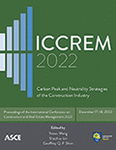Study on Carbon Reduction Capacity of Sponge City Facilities
Publication: ICCREM 2022
ABSTRACT
The rapid development of urbanization in China leads to the continuous decrease of surface permeability, the continuous increase of carbon emissions, and the increase of flood disasters and nonpoint source pollution. The sponge city facilities can increase surface permeability and green area, and reduce surface runoff, nonpoint pollution, and carbon emissions. In this study, the carbon reduction mechanism of different sponge city facilities such as green roof, permeable pavement, raingarden, and bioretention cell was analyzed, and corresponding calculation model of carbon reduction capacity was constructed. The life cycle assessment was used to compare the carbon emissions of the sponge city facilities with the traditional development. The results are helpful to optimizing the layout of sponge city facilities and realizing the goal of carbon neutralization in China as soon as possible.
Get full access to this article
View all available purchase options and get full access to this chapter.
REFERENCES
Ahiablame, L. M., Engel, B. A., and Chaubey, I. (2012). “Effectiveness of low impact development practices: Literature review and suggestions for future research.” Water Air and Soil Pollution, 223(7), 4253–4273.
Chang, L. F., Lin, C. H., and Su, M. D. (2008). “Application of geographic weighted regression to establish flood-damage functions reflecting spatial variation.” Water SA, 34 (2), 209–216.
Chen, P. Y., Li, Y. H., Lo, W. H., and Tung, C. P. (2015). “Toward the practicability of a heat transfer model for green roofs.” Ecological Engineering, 74, 266–273.
China Architectural Design and Research Institute. (2016). Technical code for rainwater control and utilization engineering of buildings and communities (GB50400-2016), Beijing, China. (in Chinese).
Drake, J., Bradford, A., and Van Seters, T. (2014). “Hydrologic performance of three partial-infiltration permeable pavements in a cold climate over low permeability soil.” Journal of Hydrologic Engineering, 19(9), 04014016.
Huang, N. J., Zhang, B. L., Zhu, W. T., Zhang, R. X., Rong, W. L., and Li, X. G. (2018). “Goal set and case breakdown of a special sponge city planning in new zone.” Journal of Municipal Technology, 36(05), 130–134. (in Chinese).
Huang, J. (2018). “Cost model of total reduction of COD and ammonia nitrogen in sewage treatment plant.” Chemical Design Communication, 44(11), 207. (in Chinese).
Jia, L. Y. (2016). Research on the Optimization of Sponge Construction and Low Carbon Emission Reduction Technology. Tianjin University, Tianjin, China, 1–71. (in Chinese).
Jonkman, S. N., Brinkhuis-Jak, M., and Kok, M. (2004). “Cost benefit analysis and flood damage mitigation in the Netherlands.” Heron, 49 (1), 95–111.
Kim, J., Hong, T., and Koo, C. (2012). “Economic and environmental evaluation model for selecting the optimum design of green roof systems in elementary schools.” Environmental Science & Technology, 46(15), 8475–8483.
Lee, E. H., and Kim, J. H. (2018). “Development of a flood-damage-based flood forecasting technique.” Journal of Hydrology, 563, 181–194.
Lei, X. J. (2020). “Photosynthesis is carbon sink.” China Energy, 42(06), 4–12. (in Chinese).
Li, C. L., Zheng, T., Peng, K. M., Cheng, W., Xu, J. C., Qiao, J. L., and Huang, J. W. (2019). “Study on carbon emission of sponge city stormwater system based on life cycle assessment.” Environment and Sustainable Development, 44(01), 132–137. (in Chinese).
Lin, X. H., Ren, J., and Xu, J. C. (2018). “Prediction of life cycle carbon emissions of sponge city projects: A case study in Shanghai, China.” Sustainability, 11, 3978.
Liu, J., Wang, J., Ding, X., Shao, W., Mei, C., Li, Z., and Wang, K. (2020). “Assessing the mitigation of greenhouse gas emissions from a green infrastructure-based urban drainage system.” Applied Energy, 278, 115686.
Liu, X. X. (2020). Research on the Effect of Lid Facilities on Rainwater Runoff Pollution Reduction in Campus Area. Chongqing Jiaotong University, Chongqing, China, 1–81. (in Chinese).
Liu, Y., Zhang, L., Zhang, Q., Li, Y., Wang, X. M., and Zhang, J. F. (2021). “Performance evaluation of urban lawn system in controling the pollutants in roof runoffs.” Journal of Xi’an University of Architecture and Technology (Natural Science Edition), 53(01), 132–137. (in Chinese).
Lu, J., and Guo, Q. (2020). “Urban road plant landscape design based on low carbon concept.” Modern Horticulture, 243(16), 77–78. (in Chinese).
Ma, J., and Wu, X. G. (2018). “Study on carbon emission of typical measures in sponge city.” Urban Forestry in China, 16(02), 27–32. (in Chinese).
Ma, J. (2018). Carbon Source Analysis and Carbon Emission Study of Typical Measures for Sponge City Construction. Shanxi Agricultural University, Shan Xi, China, 1–45. (in Chinese).
Mentens, J., Raes, D., and Hermy, M. (2006). “Green roofs as a tool for solving the rainwater runoff problem in the urbanized 21st century.” Landscape and Urban Planning, 77(3), 217–226.
MHURD (Ministry of Housing and Urban Rural Development). (2018). Assessment standard for sponge city construction effect (GB/T 51345-2018). China Architecture and Building Press, Beijing. (in Chinese).
MHURD (Ministry of Housing and Urban Rural Development). (2014). “Technical guideline for sponge city construction-low impact development rainwater system construction (trial).” <http://jst.jl.gov.cn/csjs/wjxx/201412/P020141222565834965487.pdf> (Mar.31, 2022). (in Chinese).
Seyedabadi, M. R., Karrabi, M., and Nabati, J. (2022). “Investigating green roofs’ CO2 sequestration with cold-and drought-tolerant plants (a short-and long-term carbon footprint view).” Environmental Science and Pollution Research, 29(10), 14121–14130.
Sichuan Minghong Vehicle Manufacturing Co., Ltd. (2019). “Carbon emission of new energy vehicles.” <https://zhuanlan.zhihu.com/p/55394854>(Mar.31, 2022). (in Chinese).
Zhang, Q. (2021). “Current situation analysis, law understanding and countermeasures of water treatment in China.” National Governance, (37), 11–16. (in Chinese).
Information & Authors
Information
Published In
History
Published online: Dec 15, 2022
Authors
Metrics & Citations
Metrics
Citations
Download citation
If you have the appropriate software installed, you can download article citation data to the citation manager of your choice. Simply select your manager software from the list below and click Download.
